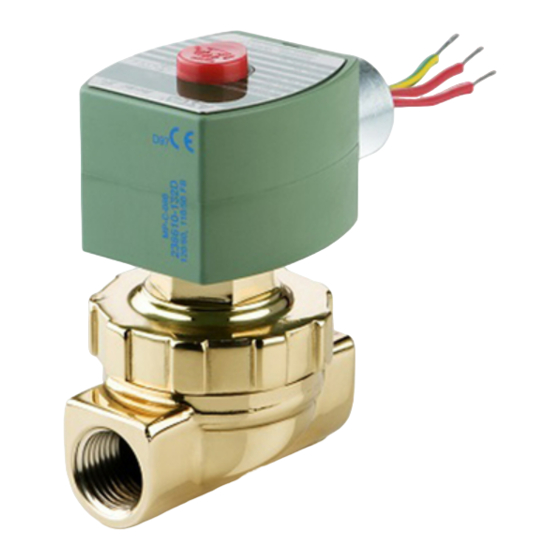Table of Contents
Advertisement
Quick Links
Installation & Maintenance Instructions
2-WAY INTERNAL PILOTED-OPERATED SOLENOID VALVES
3/4I and 1I NPT - BRASS CONSTRUCTION
NOTICE: See separate solenoid installation and maintenance
instructions for information on: Wiring, Solenoid Temperature,
Cause of Improper Operation, Coil or Solenoid Replacement.
DESCRIPTION
Series 8210 valves are 2-way normally closed internal
pilot-operated solenoid valves designed for general service. Valves
are made of rugged forged brass. Series 8210 valves are provided
with a general purpose solenoid enclosure.
Series EF8210 and 8211 are the same as Series 8210 except they are
provided with an explosionproof or explosionproof/watertight
solenoid enclosure.
OPERATION
Normally Closed: Valve is closed when solenoid is de-energized;
open when energized.
NOTE: No minimum operating pressure differential required.
Manual Operator (optional feature)
Manual operator allows manual operation when desired or during an
electrical power outage.
S For 3/4I NPT Valve Construction - To engage manual
operator (open valve), rotate stem clockwise as far as possible.
Valve will now be in the same position as when the solenoid is
energized.
To disengage manual operator, rotate stem
counterclockwise as far as possible.
CAUTION: For valve to operate electrically, manual
operator must be fully disengaged (stem rotated fully
counterclockwise).
S For 1I NPT Valve Construction - To engage manual operator
(open valve), push knobs upward and rotate one quarter turn.
Valve will now be in the same position as when the solenoid is
energized. To disengage manual operator, rotate manual
operator one quarter turn until the manual operator
disengages and returns to its original position.
CAUTION: For valve to operate electrically, manual
operator stem must be fully retracted.
INSTALLATION
Check nameplate for correct catalog number, pressure, voltage,
frequency, and service. Never apply incompatible fluids or exceed
pressure rating of the valve. Installation and valve maintenance to be
performed by qualified personnel.
Future Service Considerations
Provision should be made for performing seat leakage, external
leakage, and operational tests on the valve with a nonhazardous,
noncombustible fluid after disassembly and reassembly.
e
50 Hanover Road, Florham Park, New Jersey 07932
NORMALLY CLOSED OPERATION
MM
All Rights Reserved.
Temperature Limitations
For maximum valve ambient and fluid temperatures, refer to chart
below. Check catalog number prefix and watt rating on nameplate.
Catalog
Watt
Number
Rating
Prefix
AC/DC
15.4
None, DF
None, DF
or HT
AC
None, KF,
SF or SC
16.1
16.1
HT, KH,
AC
ST or SU
None, HB
20
or DP
AC
None, KP ,
SP or SD
20.1
20.1
HB, KB,
AC
SS or SV
30.6
HT
DC
Positioning
Valve must be mounted with solenoid vertical and upright.
Piping
Connect piping to valve according to markings on valve body. Apply
pipe compound sparingly to male pipe threads only. If applied to
valve threads, the compound may enter the valve and cause
operational difficulty. Avoid pipe strain by properly supporting and
aligning piping. When tightening the pipe, do not use valve or
solenoid as a lever. Locate wrenches applied to valve body or piping
as close as possible to connection point.
CAUTION: To protect the solenoid valve, install a strainer
or filter suitable for the service involved in the inlet side as
close to the valve as possible. Clean periodically depending
on service conditions. See ASCO Series 8600, 8601 and 8602
for strainers.
WARNING: To prevent the possibility of death,
serious injury or property damage, turn off electrical
power, depressurize valve, and vent fluid to a safe area
before servicing the valve.
NOTE: It is not necessary to remove the valve from the pipeline for
repairs.
Printed in U.S.A.
www.ascovalve.com
SERIES
8210
8211
Form No.V5411R4
Maximum
Coil
Ambient
Class
Temp.
F or H
F or H
125_F(51.7_C)
125_F(51 7_C)
F
125_F(51.7_C)
H
140_F(60_C)
200_F(93_C)
200_F(93_C)
F or H
77_F(25_C)
F
125_F(51.7_C)
H
140_F(60_C)
H
77_F(25_C)
MAINTENANCE
Page 1 of 4
Maximum
Fluid
Temp.
77_F(25_C)
Advertisement
Table of Contents

Summary of Contents for Asco 8210 series
- Page 1 CAUTION: For valve to operate electrically, manual close to the valve as possible. Clean periodically depending on service conditions. See ASCO Series 8600, 8601 and 8602 operator stem must be fully retracted. for strainers.
- Page 2 75 ± 10 in-lbs [8,5 ± 1,1 Nm]. S Excessive Leakage: Disassemble valve and clean all parts. If parts 9. Install solenoid. See separate instructions. are worn or damaged, install a complete ASCO Rebuild Kit. WARNING: To prevent the possibility of death, Valve Disassembly serious injury or property damage, check valve for proper operation before returning to service.
- Page 3 Indicates Parts Supplied In ASCO Rebuild Kits Figure 1. Series 8210 valve without solenoid - 3/4I NPT - AC construction. solenoid base sub-assembly bonnet gasket bonnet screw (4) Indicates Parts Supplied...
- Page 4 Special wrench supplied in ASCO Rebuild Kit. For wrench kit only order No. K168146-001 solenoid base sub-assembly milled flats for wrenching housing wrenching flats 1/2I NPT conduit connection bonnet gasket bonnet screw (4) and lockwasher valve bonnet core spring (closed end protrudes...















Need help?
Do you have a question about the 8210 series and is the answer not in the manual?
Questions and answers